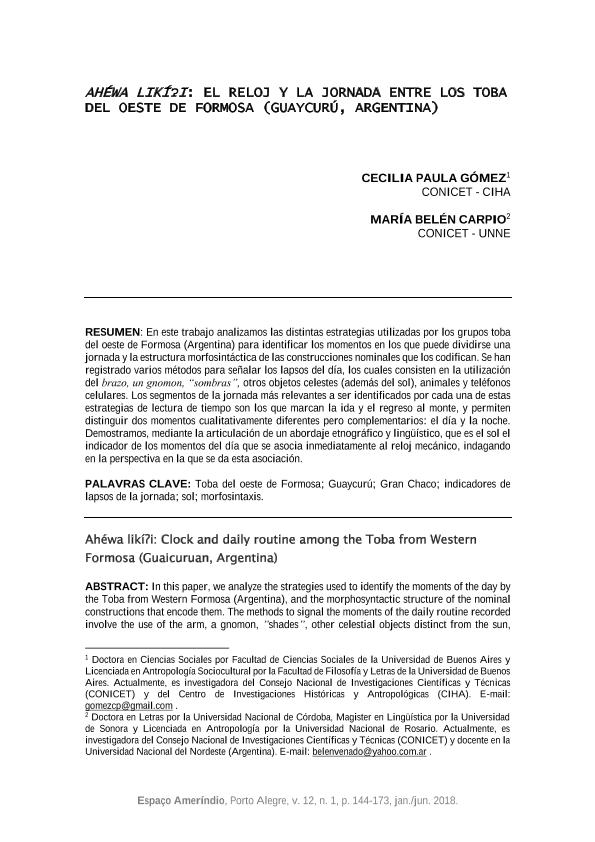Mostrar el registro sencillo del ítem
dc.contributor.author
Gomez, Cecilia Paula

dc.contributor.author
Carpio, María Belén

dc.date.available
2020-02-18T16:00:04Z
dc.date.issued
2018-06
dc.identifier.citation
Gomez, Cecilia Paula; Carpio, María Belén; Ahéwa likíʔi: El reloj y la jornada entre los Tobas del oeste de Formosa (Guaycurú, Argentina); Universidade Federal do Rio Grande do Sul; Espaço Ameríndio; 12; 1; 6-2018; 144-173
dc.identifier.issn
1982-6524
dc.identifier.uri
http://hdl.handle.net/11336/97895
dc.description.abstract
En este trabajo analizamos las distintas estrategias utilizadas por los grupos toba del oeste de Formosa (Argentina) para identificar los momentos en los que puede dividirse una jornada y la estructura morfosintáctica de las construcciones nominales que los codifican. Se han registrado varios métodos para señalar los lapsos del día, los cuales consisten en la utilización del brazo, un gnomon, “sombras”, otros objetos celestes (además del sol), animales y teléfonos celulares. Los segmentos de la jornada más relevantes a ser identificados por cada una de estas estrategias de lectura de tiempo son los que marcan la ida y el regreso al monte, y permiten distinguir dos momentos cualitativamente diferentes pero complementarios: el día y la noche. Demostramos, mediante la articulación de un abordaje etnográfico y lingüístico, que es el sol el indicador de los momentos del día que se asocia inmediatamente al reloj mecánico, indagando en la perspectiva en la que se da esta asociación.
dc.description.abstract
In this paper, we analyze the strategies used to identify the moments of the day by the Toba from Western Formosa (Argentina), and the morphosyntactic structure of the nominal constructions that encode them. The methods to signal the moments of the daily routine recorded involve the use of the arm, a gnomon, ”shades”, other celestial objects distinct from the sun, animals, and cell phones. The most relevant segments of the journey to be identified by each of these indicators of moments of the day are departure to and arrival from the forest. They distinguish two qualitative distinct but complementary moments: day and night. Hence, from an ethnographic and linguistic approach, we demonstrate that the sun is the time indicator that is directly associated to the clock, and study the perspective from which this link is made.
dc.format
application/pdf
dc.language.iso
spa
dc.publisher
Universidade Federal do Rio Grande do Sul

dc.rights
info:eu-repo/semantics/openAccess
dc.rights.uri
https://creativecommons.org/licenses/by-sa/2.5/ar/
dc.subject
TOBAS DEL OESTE DE FORMOSA
dc.subject
GUAYCURÚ
dc.subject
GRAN CHACO
dc.subject
INDICADORES DE LAPSOS DE LA JORNADA
dc.subject
SOL
dc.subject
MORFOSINTAXIS
dc.subject
FORMOSA
dc.subject
ARGENTINA
dc.subject.classification
Ciencias Sociales Interdisciplinarias

dc.subject.classification
Otras Ciencias Sociales

dc.subject.classification
CIENCIAS SOCIALES

dc.title
Ahéwa likíʔi: El reloj y la jornada entre los Tobas del oeste de Formosa (Guaycurú, Argentina)
dc.title
Ahéwa likíʔi: Clock and daily routine among the Toba from Western Formosa (Guaicuruan, Argentina)
dc.type
info:eu-repo/semantics/article
dc.type
info:ar-repo/semantics/artículo
dc.type
info:eu-repo/semantics/publishedVersion
dc.date.updated
2019-10-24T18:19:50Z
dc.journal.volume
12
dc.journal.number
1
dc.journal.pagination
144-173
dc.journal.pais
Brasil

dc.journal.ciudad
Puerto Alegre
dc.description.fil
Fil: Gomez, Cecilia Paula. Consejo Nacional de Investigaciones Científicas y Técnicas; Argentina. Universidad de Buenos Aires. Facultad de Filosofía y Letras. Instituto de Ciencias Antropológicas; Argentina
dc.description.fil
Fil: Carpio, María Belén. Consejo Nacional de Investigaciones Científicas y Técnicas. Centro Científico Tecnológico Conicet - Nordeste. Instituto de Investigaciones Geohistóricas. Universidad Nacional del Nordeste. Instituto de Investigaciones Geohistóricas; Argentina
dc.journal.title
Espaço Ameríndio
dc.relation.alternativeid
info:eu-repo/semantics/altIdentifier/url/https://seer.ufrgs.br/EspacoAmerindio/article/view/75424
dc.relation.alternativeid
info:eu-repo/semantics/altIdentifier/doi/https://doi.org/10.22456/1982-6524.75424
Archivos asociados
